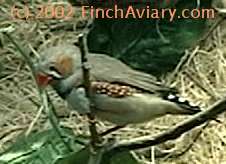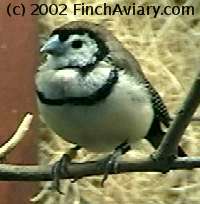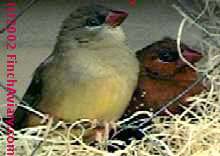Our
Tragic Experience
One
November, I came home to find one of my zebras dead in his nestbox.
I was shocked and devastated. He was my favorite zebra, sweeter
and gentler than his more aggressive zebra peers. In fact, he
preferred the company of a gentle owl finch to the company of
any of the other zebras, and even shared a nestbox with this
owl (since I do not breed, this interspecies relationship did
not bother me).
I
had not seen any sign of illness in this bird. I do not know
if I was not paying enough attention or if he did not show signs,
but I had no clue this was coming. Since I did not know his
age and hadn't seen any signs, I dismissed his death to natural
causes - some type of organ failure, perhaps. But I kept an
eye on his owl friend, just in case.
At
first, the owl seemed fine. He paired up with Peeper, who I
believe was an owl-society hybrid (though I don't know anything
about his origin and I can't say for sure). Peeper used to hang
out with the societies, but when this lonely owl started to
show signs of affection, he abandoned the societies for the
constant companionship of the owl.
I
hate to say it, but in a few weeks I started to see signs of
the illness in my owl finch. He became more lethargic. He frequently
slept while the other birds were active. But I didn't trust
my instincts. I thought I was being paranoid. I guess I didn't
want to believe it and so was in denial. About a month after
my zebra had died, I lost my sweet, gentle owl finch to the
same illness.
Now
I was just sick. Two of my favorite birds lost, and one I should
have at least tried to save. There was no question I was responsible.
And I was not going to let myself go into denial again. This
time, my devoted attention was focused on Peeper. He had been
nesting with the owl for about three weeks. If the disease would
spread, he would be the likely target.
Sure
enough, in a couple of weeks he started showing the same signs
of lethargy. He stopped singing. He was just very slightly not
quite the same bird. I made an appointment with the vet. But
alas, when the appointment came, we were hit by a terrible snow
storm. I was in the last trimester of my pregnancy and the vet
was far away - I was too afraid to make the trip. I rescheduled,
but I had to make the next appointment on a Saturday because
I had no more sick time due to all my prenatal doctor visits.
Saturday's are always booked up quickly, so the next available
appointment wasn't for a few weeks.
But
Peeper was starting to look better to me. Either that, or I
had become accustomed to his "sick" behavior. I was
no longer sure there was anything really wrong - I might just
be looking for problems that were not there.
By
the time his appointment rolled around, I was pretty sure he
really was sick. He had gotten worse. He was fluffed up a lot
of the time. He would spend much of his time on the ground,
rummaging through spilt seed, or up in a perch, sleeping. When
healthy, he was a very social bird. Now he rejected the company
of others.
When
I brought him in to the vet, she could tell right away that
he was ill. He did not even make an attempt to cover up his
"fluffiness." His fecal sample indicated he was suffering
from an enteritis infection. He was very thin and breathing
hard. I had to leave him at the bird medical center for hospitalization
while they tried to treat the infection and build his weight
back up.
In
the care of the veterinarians, he managed to recover from the
enteritis infection. After about a week, there was no sign of
enteritis in his stool sample. But he still was not recovering
like he should have been. They suspected perhaps Aspergillosis
was at the bottom of this because I used corncob bedding on
the aviary floor at that time. He would need an X-ray to try
to diagnose the problem.
In
the meantime, I got rid of all of the corncob bedding and have
not used it again to this day. I tried many different alternatives,
but finally settled on newspaper as the safest material. After
some time, I switched to Kraft paper because it came on rolls
and could be cut to size and because it had a nicer appearance.
The
day of the X-ray, Peeper seemed to be doing better. But when
they went to get him for the procedure, they found him dead
suddenly in the hospital cage.
I
can't tell you how crushing this news was to me. I had been
intent on saving this bird and on putting a stop to this infection.
I failed. Once again, I had acted too late.
I
agreed to pay for a necropsy in order to obtain some clue as
to what was happening to my birds. The necropsy showed no signs
of Aspergillosis as had been suspected, but many of the organs
were abnormally enlarged. This could have been caused by many
different things. Two of the possible culprits were Polymyxavirus
and Atoxoplasmosis, both of which are very difficult to impossible
to treat, and even disinfectants such as bleach would have little
to no effect in containing the spread.
I
agreed to have samples sent to California to try to confirm
or negate any of these hypotheses. Unfortunately, the results
were inconclusive. They couldn't rule it out but they couldn't
confirm it either. All I could do is wait and see.
Lo
and behold, a fourth bird got sick. My male strawberry. Same
symptoms but to a lesser degree: he had stopped singing, was
occasionally puffed up, was less active, and avoided contact
with the other birds, spending a lot of time at the bottom of
the aviary sifting through the spilt seed. I acted immediately:
I took a vacation day that I had been reserving for my maternity
leave and brought him in to the vet.
He
had the same enteritis as Peeper, but he was in much better
physical shape because I had caught it early enough. The strawberry
was able to come back home with me, but we had to administer
an antibiotic twice a day orally for a couple of weeks. The
antibiotic cleared up the enteritis and when I brought him in
for his follow-up visit, he was in much better shape. It was
unknown whether he also had whatever had killed Peeper - we
could only wait and see. No other symptoms surfaced, and he
was allowed to return to the aviary after an observation period.
He has been just fine ever since (more than a year as of this
writing). We never found out what it was that killed Peeper.






